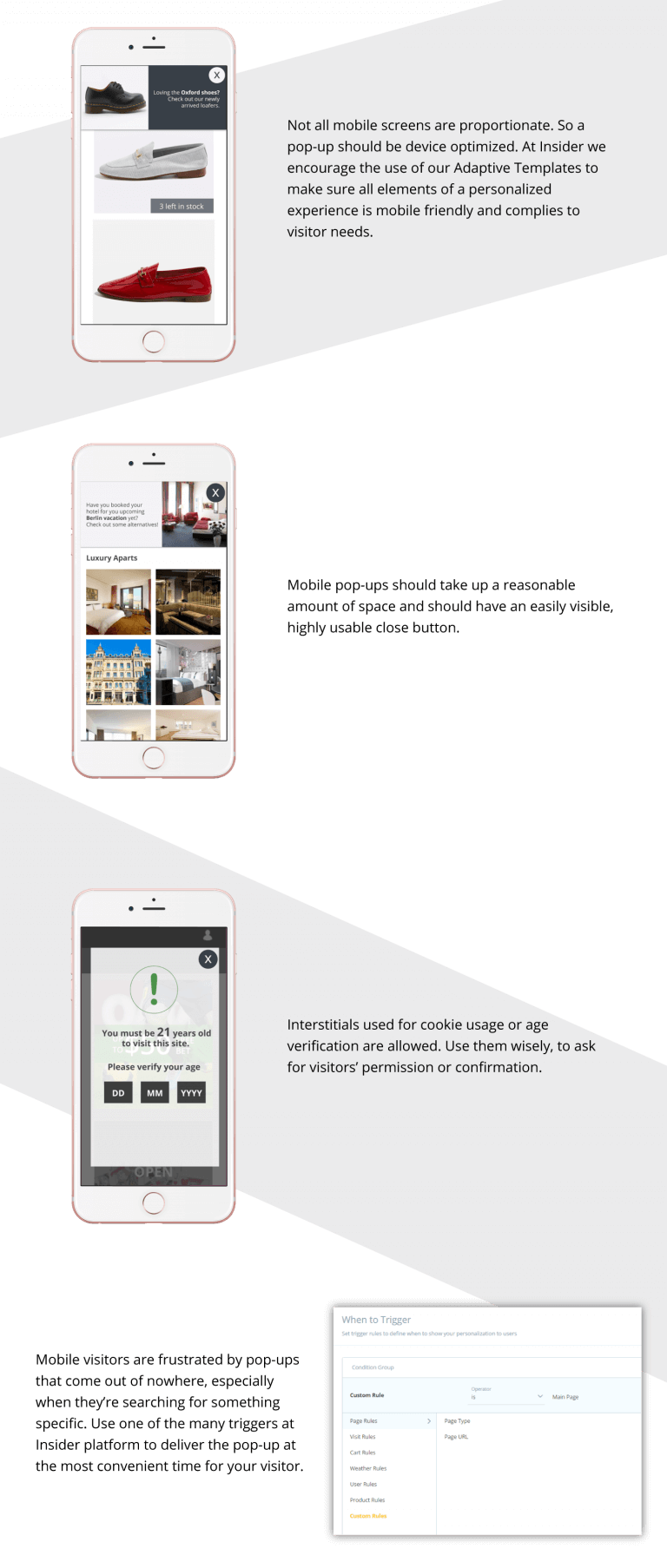 Srikant Kotapalli
Srikant Kotapalli
Mar 10, 2017
 Srikant Kotapalli
Srikant Kotapalli
Mar 10, 2017
Google will start penalizing pop-ups: Here’s what to do.
What does the restriction mean for marketers?
What really frustrates visitors?
Here are some best practices we share with Insider partners to avoid punishments
Thanks to Google’s mobile-friendly label, 85% of websites have adopted mobile responsive strategies. Last summer though, Google has announced they’re removing the mobile-friendly label, implying that mobile-responsiveness goes without saying. Although the label is now removed, being mobile friendly is still a ranking factor and now there are specific restrictions about the usage of pop-ups and interstitials in mobile web. Google now takes more in-depth precautions in terms of making mobile web a highly usable space.
Last August in 2016, Google had announced upcoming pop-up restrictions and probable penalties regarding the inappropriate use of mobile pop-ups. Google calls these pop-ups intrusive interstitials and the term refers to the mobile web pop-ups that block the entire page and appear on a search transition on mobile. As these types of pop-ups prevent the visitors from reaching the content they’re searching for, as of January 2017, Google put specific restrictions into action for the mobile web to become more visitor friendly.
“Pages that show intrusive interstitials provide a poorer experience to users than other pages where content is immediately accessible. This can be problematic on mobile devices where screens are often smaller. To improve the mobile search experience, after January 10, 2017, pages where content is not easily accessible to a user on the transition from the mobile search results may not rank as highly.”
Still, mobile visitors are having frustrating experiences, running into a lot of blockages and not finding what they’re looking for. Mobile web is intrinsically a narrow space to deliver content and cramped design solutions hinder visitors from having the most convenient experience, plus they cost brands significantly decreased conversion rates. When mobile visitors search on Google and click on one of the results, they desire to go to a certain page and see what they’re searching for. Interstitials, the pages appearing before the expected content page, and intrusive popups block the actual content on the site, delivering a frustrating experience to the visitor.
At Insider, we’ve received so many inquiries both from our associates and friends about what the regulation will change. Let’s discover what the restriction means for visitors and marketers. Although marketers panicked to adapt to the regulations, the situation is actually not alarmingly dire. Marketers and business owners are intimidated that they can’t leverage the offerings of a pop-up on the mobile web anymore, like collecting emails, delivering ads and generating website traffic. However, the restriction applies to mostly the interstitials used in mobile web. The official announcement focuses greatly on the use of interstitials while encouraging the appropriate use of mobile pop-ups.
“We previously explored a signal that checked for interstitials that ask a user to install a mobile app. As we continued our development efforts, we saw the need to broaden our focus to interstitials more generally.”
Google’s penalty for misuse of mobile pop-ups and interstitials is to lower the ranking of the page. However, Google reminds in the official announcement that this is only one of the hundreds of ranking factors.
“Remember, this new signal is just one of the hundreds of signals that are used in ranking. The intent of the search query is still a very strong signal, so a page may still rank highly if it has great, relevant content.”
Other ranking factors are still relevant as we’ve known and practiced them to this day. Delivering personalized pop-ups or interstitials that are real time and based on the search intent is still one of the key factors determining the quality of mobile web experiences and indirectly your page’s ranking. At Insider, we believe in delivering unique experiences and we make sure that every element that we deploy in the mobile web is aligned with visitor needs and Google principles.
A great part of mobile pop-ups are originally set up for desktop and does not respond to all mobile screen sizes. Most mobile visitors are frustrated by being delivered pop-ups that are not relevant, not fully responsive or usable.

Considering a great part of Google search is done on mobile devices, Google takes steps to improve mobile experiences to be more seamless and convenient. It’s important to remember that not all pop-ups or interstitials are restricted altogether. To be precise about the scope of the improvement, the restriction only applies to the transition from search results to the page you’re directed. However, there are some cases where interstitials are legally allowed and in fact, necessary. For instance, on a website where the user is supposed to specify their age before entering, full-page interstitials can be used. Google penalizes misuse of pop-ups by lowering the rank of the corresponding page.
At Insider, thanks to our big team of technology enthusiasts and software devotees, we follow the tech trends and news very closely. We always try to be a step ahead in terms of adopting innovations, finding better customer experience solutions and optimizing our products accordingly. We put importance in our mobile pop-ups’ being compatible with all screen sizes and resolutions and having a native look to assure the visitor that they’re still on the page they wanted to go.
Another principle we take by heart to make mobile web more usable is the timing of pop-ups and interstitials. Both being valuable marketing features, they should be delivered to right audiences at the right time. Although we usually determine the right time through A/B/n Testing, delivering them at points where the engagement is a go-to best practice, like when a visitor scrolls 170 px or they go the second page, etc.


Written by
Srikant Kotapalli
Srikant is a seasoned product marketing leader with 15+ years of experience in building and marketing SaaS products. As VP of Product Marketing at Insider, Srikant is responsible for Insider's product positioning, GTM and analyst relations. When not working on product marketing projects, Srikant loves exploring the design and engineering of things